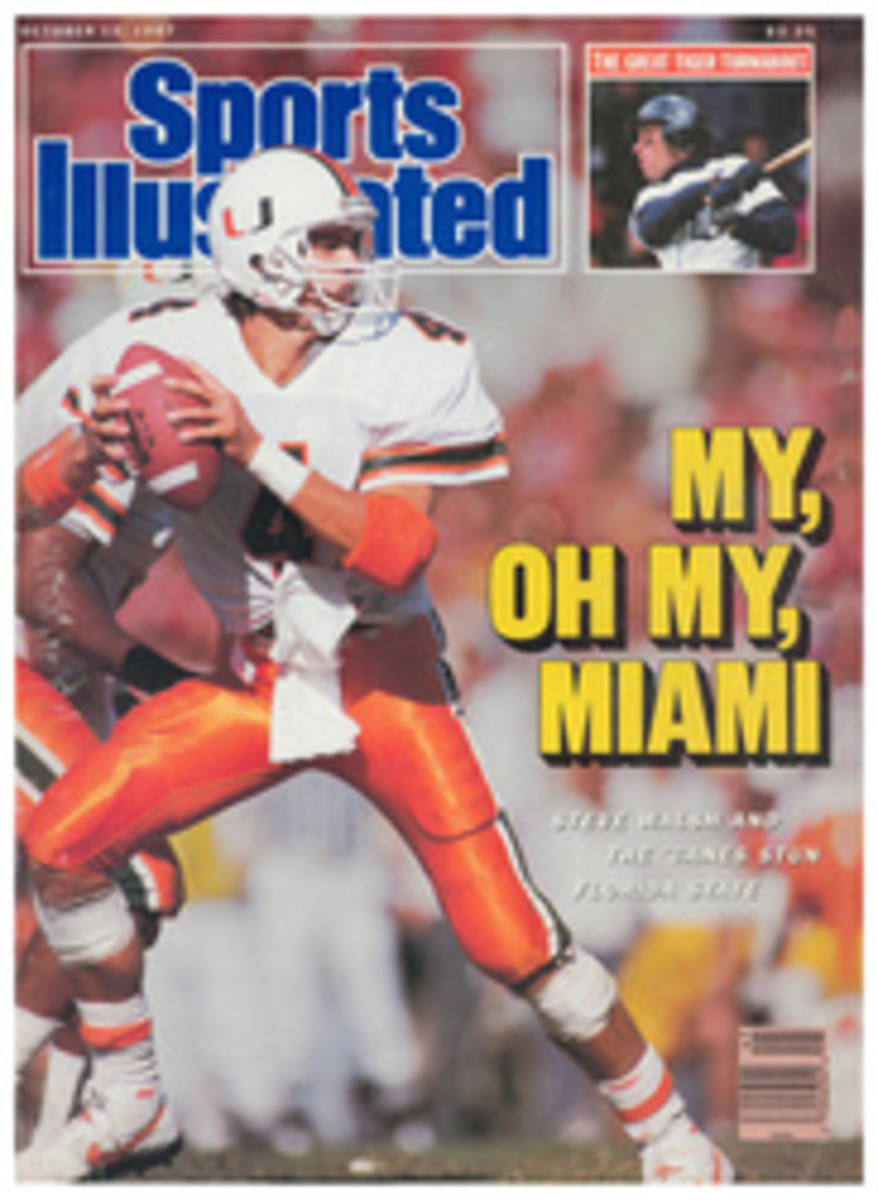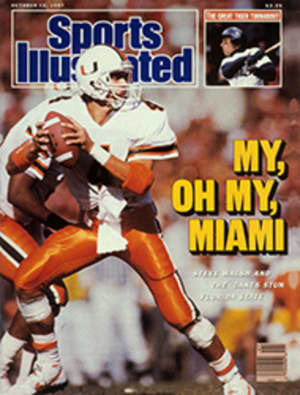
NOW THIS KID REALLY PLAYED HARDBALL—WITH A MARBLE
Fathers must be the most frustrated species on the planet. From the time tots are old enough to insert the cat's tail into a wall socket, dads have big plans for them—and are bound to be disappointed. For instance, my dad, a mechanical engineer, wanted me to be a rocket scientist. No sooner had I been toilet trained than he began surrounding me with technical toys. While other kids were getting baseball gloves and bicycles for Christmas, I was getting Erector Sets, chemistry sets and microscopes.
What Dad failed to realize was that I hadn't even the faintest interest in science or physics. The only thing I cared about was the Milwaukee Braves. From the time the Braves blew a three-games-to-one lead to the Yankees in the 1958 World Series—and even after the Braves skipped to Atlanta—I was hooked.
Radio station WTMJ in Milwaukee was my primary link with Hank Aaron, Eddie Mathews, Joe Adcock, Del Crandall, Warren Spahn and Lew Burdette. The radio became my constant companion after my parents sent my older sister away to boarding school. My room became a sanctuary in which I would listen to distant baseball games and fantasize about future glory on the diamond. I would dream up games between the Braves and my other favorite National League team, the slugging Giants of Willie Mays, Willie McCovey, Orlando Cepeda and Jim Davenport.
While listening to a game between the Braves and the Giants one day, I was toying with a marble on my desk. The marble got away and rolled to a stop against a pencil. My imagination took over. I wondered if striking a falling marble with a pencil was as difficult as getting a bat on one of Spahn's fastballs. To my satisfaction, I discovered the same hand-eye coordination was required. At first I barely made contact. Then I managed a few dribblers. With practice I was stroking soft liners. Soon I was smacking high drives off the bedroom window. The resulting ping brought Dad into the room.
"What was that?" he asked.
"Nothing."
"How can you write holding a pencil upside down?"
"I was just tapping to the music."
"What music? All you ever listen to is baseball and rock 'n' roll."
"I was tapping to the organ music in the background of the game."
Giving me a long suspicious look, Dad left the room. I locked the door. He was on to something. So was I.
Out came the Erector Set, the chemistry set and the microscope. All the pieces remained inside, however. By placing the green Erector Set box on its side on the floor in front of my dresser, I fashioned my own version of the leftfield wall in Fenway Park. The black chemistry set container made a nice hitter's background and centerfield wall, and the narrower microscope case made a convenient hitter's porch in right. Now I had a magical baseball park of my own. All I needed was a couple of teams.
I scrounged around for 18 pencils and saved the 9 best ones for the Braves. They were mostly blue, my favorite color. The ugly yellow and green ones were for the Giants.
I placed nine pencils around my homemade diamond according to the positions of the team in the field and allowed three swings per pencil (I batted fungo-style while kneeling on the carpet; the plate was about seven feet from the outfield walls) for the team at bat. The ground rules were simple. If the marble rolled against any of the six "infielders," it was a ground out. All infield flies were pop-outs. Anything that went over the infielders and landed without hitting one of the "outfielders" was a single. Anything off the wall was a double. If the marble ricocheted off two or more walls it was a triple. Anything over the barriers was a home run.
Oh what fun I had that summer! At first the home runs were few and far between, but the more I played, the more the marbles started flying out of my versions of County Stadium or Candlestick Park (I would face my electric fan against home plate to simulate the brisk winds of Candlestick). I later fashioned dugouts out of old shoe boxes and even supplied my own play by play, which came easily after listening to countless broadcasts.
About all I lacked was the roar of the crowd as I was accustomed to hearing it over the radio. That took some practice. I finally came up with a facsimile, which was half belch, half scream—similar to the sound a person makes after eating something extremely hot. The first roar of the crowd brought Dad into my room.
"Are you teasing the cat again?"
"The cat's not in here."
"Then what was that awful noise? Are you listening to that rock 'n' roll trash again?"
Dad noticed the pencils scattered about the room.
"What are all those pencils doing on the floor?"
"Oh, those? I'm just trying a little experiment."
"Really, now. So what's the marble's role in this?"
"Uh, well, I'm trying to measure the trajectory of a spherical object when struck by a cylindrical object at various angles and speeds."
An eyebrow went up. But he left without further inquiry.
The games went on. And on. And on. I planned to complete a full 162-game schedule between the Braves and Giants before the summer was over, and each game took about an hour. I was careful to hold down the crowd noise when the folks were home, but I relished the times they were away. Then the room shook with noise—and with flying marbles.
Holding down the cheering wasn't always easy, especially when Aaron launched one over the dresser or made a pencil-point catch in the outfield. At times like that, the noise was spontaneous. One time it was too loud. Dad charged into the room and caught me red-handed.
"Don't tell me you're experimenting with the theory of inertia," he bellowed.
I was forced to confess. I was a pencil baseball junkie. When I explained that the microscope, Erector and chemistry sets were merely props, Dad shook his head and stalked out of my room, muttering to himself.
My guilt didn't stop me from playing. I was addicted to this solitary game. It became a sore spot between us. When the fans roared in my make-believe stadium, I heard Dad moan, "Mother, that kid is making those ridiculous noises again. Two hundred dollars' worth of scientific equipment in there and the kid shuffles pencils like some moron."
Dad once stormed into the room and stepped right on Aaron, cracking him in half. It was a devastating blow to Milwaukee's pennant drive. I had no other pencils around with a barrel as big and as long as Hank's. I didn't even have a (Hurricane) Bob Hazle to call up as the '57 Braves did when Bill Bruton hurt his knee. All I had was a skinny one with no power—Ty Cline I called him, after the outfielder who hit one home run in three years for the Braves of the early 1960s.
My worst fears came true. The Giants started closing in. An 11-game Milwaukee lead shrank to 2 in August. I always tried to swing with the same velocity for each team, and without Aaron's big bat, the Braves could not match the power of Mays, McCovey, Cepeda and Davenport.
Out of desperation, I decided to piece my heavy hitter together with model glue and friction tape. I held my breath as I swung the Aaron pencil the first time he came off the disabled list. To my utter delight, the marble put a dent in the Erector-Set-box-turned-Green-Monster.
Not only had the tape made Aaron's barrel wider it also had made it heavier. Like his real-life counterpart, my Aaron tore up the league, rocketing marbles all over the room—off the lamp shade, off the upper bunk bed and off my copy of The Young Scientist, which was collecting dust on the bookshelf. Talk about poetic justice! The most historic shot came in the pennant-clinching game. With the Braves trailing 6-5 in the bottom of the ninth, Aaron came to bat with the bases loaded and one out. On an 0-2 pitch he zapped one all the way to the ceiling. It bounced off the glass light fixture, cracking it, and then dropped cleanly into the outfield, which made it a ground-rule double.
"Milwaukee wins the pennant! Milwaukee wins the pennant!" I screamed. Within seconds. Dad came dashing into the room. The crack in the light fixture told him all he needed to know. The ensuing deduction from my allowance, however, was worth every single penny.
My Braves went on to avenge—at least in my mind—the 1958 World Series debacle by sweeping the wretched Yankees (now represented by the Giants' pencils) in four straight. Aaron finished with 50 home runs in the regular season—despite his time on the disabled list—and one in each of the Series games.
I was sorry to see the baseball season end, but it was late October and, to me, it just didn't seem right to play ball—even indoors—that late in the fall in the Midwest. As I dismantled the stadium for the last time, I stroked the marble into one of the cardboard dugouts. It made a loud pop. Before I knew it, I was making sweeping shots with my right hand and blocking maneuvers with my left. That day pencil hockey was born. And you know what? Aaron had one heck of a wrist shot.
ILLUSTRATION
STUART GOLDENBERG
Lynn R. Houser covers sports for "The Herald-Telephone" in Bloomington, Ind.

